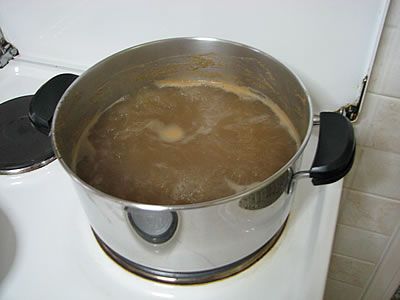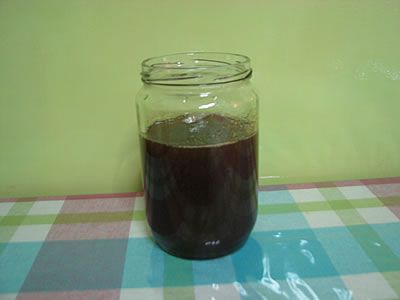A recipe for home made grape molasses (petimezi). Easily make petimezi (grape molasses) from your grape must. Petimezi can be stored for years in the refrigerator and can be used in many recipes as a sweetener and to add strong taste.
Petimezi, or grape molasses, is the dark thick sweet liquid that results from boiling the grape must. The boiling of the grape must must be done before the fermentation process begins. The fermentation of the must begins 20 to 30 hours after the extract of the grape juice.
For the make of the grape juice (must), please check the article: How to make must from grapes.
What is Petimezi (Grape Molasses or Grape Syrup)
Petimezi is a condiment made with concentrated grape juice. It is thick and sweet because of its high ratio of sugar to water. Its color is dark brown.
One of the earliest mentions of grape syrup comes from the fifth-century BC Greek physician Hippocrates, who refers to hépsēma (ἕψημα), the Greek name for the condiment. The fifth-century BC Athenian playwright Aristophanes also makes a reference to it, as does Roman-era Greek physician Galen.
Grape syrup was known by different names in Ancient Roman cuisine depending on the boiling procedure. Defrutum, carenum, and sapa were reductions of must. They were made by boiling down grape juice or must in large kettles until it had been reduced to two-thirds of the original volume, carenum; half the original volume, defrutum; or one-third, sapa. The Greek name for this variant of grape syrup was siraion (Greek: “σίραιον”).
In Turkey, grape syrup is known as pekmez.
The ancient Greek name hépsēma (now pronounced épsēma in Cypriot Greek) is still used to refer to the condiment, which is still made in Cyprus.
In Italy it is called saba, (from the Latin word sapa, with the same meaning), vincotto or vino cotto.
In Spain it is called Arrope.
In Jordan, Lebanon and Syria it is called Dibs al-anab.
For more details, please check Grape Syrup in Wikipedia.
The recipe for making Petimezi (Grape Molasses) is easy
If you want to make petimezi, the process is really simple.
Tip: Petimezi (grape molasses) is ready when 10% of the initial juice is left in the cooking pot. Use this tip to adjust the amount of Petimezi you wish to make.
Fill a cooking pot with grape juice up to 10 cm from the rim. You should not fill it to the top because the must will bubble up during boiling and produce foam. If the cooking pot is filled to the top with juice, the must will spill.
On a stove that has a heat scale of 1 to 3, start the boil at 3.
When the boil starts, we stay close to the cooking pot and stir continuously. You will see that the must will bubble up. At the same time, a dirty looking foam will begin to appear on the walls of the cooking pot, which should be removed with a ladle.

While the boiling continues, this foam will keep appearing on the walls of the cooking pot and should be removed.
Once the must has come to the initial boil, things settle down. There is no risk of the must spilling. Continue mixing.

You should begin to monitor the boiling must again when the volume is about 1/3 of the original volume. Continue stirring.
As the volume of the must decreases and it slowly turns into petimezi (grape molasses), you will see that the volume of the foam starts to increase again. If you are not careful, the cooking pot will overflow and that is not pleasant. So be careful.

When the volume of the liquid reaches 1/7 of the original volume, lower the temperature to 2 and let it continue to boil. Continue stirring.
You will already have noticed that the color of the liquid has become dark and the bubbles resemble those of a sugar syrup.
When the volume of the liquid is about 1/10 of the original volume, your grape molasses is ready.

At this point, the density of the liquid will be something between oil and thin honey.
Note: You can continue boiling if you wish. If you want to continue cooking, you can continue to stir for as long as you like. I’ve done it and I don’t recommend it.
Remove the cooking pot from the heat and pour the petimezi (grape molasses) into a sterilized glass jar.
The petimezi can be used to make mustard flour, mustard pudding, in cooking, or used instead of honey or jam on bread.
It’s an easy way to preserve for many years, grape must that you don’t plan to turn it into wine.
Storing the grape molasses (Petimezi)
You can keep Petimezi in closed jars outside the refrigerator for many months. But if you open the jar, you have to transfer it inside a refrigerator.
Inside a refrigerator, you can keep sealed jars with grape molasses for many years!
Good luck!
Tip for cleaning the cooking pot: To clean the cooking pot, put water in it and let it sit for an hour or so. You’ll find that the sticky liquid and anything else left in the cooking pot will come off very easily.
Tags: DIY • GRAPE MOLASSES • I MAKE • MUST (GRAPE JUICE) • PEKMEZ • RECIPE





